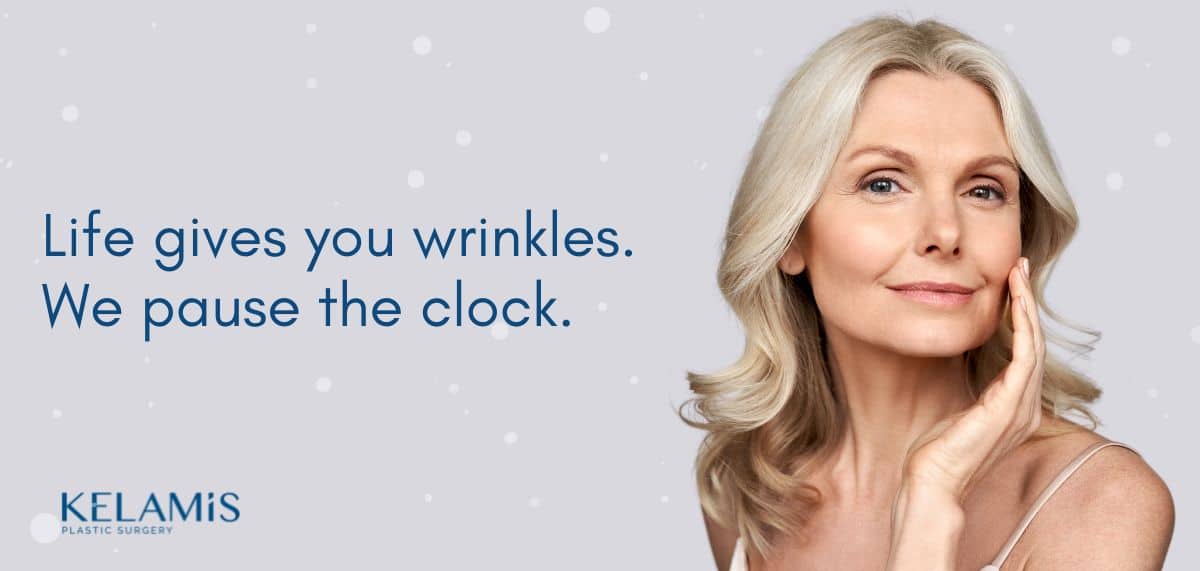
Every month is injectable month at Kelamis Plastic Surgery!

Every month is injectable month at Kelamis Plastic Surgery! Let’s start with the basics—What are injectables and how can they help you meet your wellness and beauty goals?
Injectables is a catch-all term for two types of medications injected into the face to add value by promoting overall wellness.
Neurotoxins
Botox is the most well known neurotoxin/neuromodulator. It has been around since the 1970s when it was first used in humans to temporarily paralyze facial muscles for crossed eyes or strabismus. It was FDA-approved in the late 1980s to control fine line and facial wrinkles. We’ve come a long way since those early days when the no-movement, glassy forehead was en vogue. Today’s neurotoxins include Botox, Juveau, Dysport and Xeomin.
Why would I want to use a neurotoxin?
Many people turn to neurotoxins to ‘erase’ both the static and animated wrinkles around their eyes (crows feet), on the forehead, between their eyes (the 11s) and even on the bridge of their nose (bunny lines).
How long does it take to work and how long does it last?
Everybody is unique and responds differently to each of the above neurotoxins. On average, the full effects can be reliably seen 2 weeks after treatment and last 4 or more months.
Does it hurt?
Some individuals report a light sting when the neurotoxin is injected and others aren’t bothered. We have tricks up our sleeves for making the treatment as comfortable and enjoyable as possible!
Is it true that I can prevent wrinkles by using neurotoxins in my 20s and 30s?
The general consensus is that we can slow down but not prevent wrinkles entirely with ‘prejuvenation’. The best path is a combination of early and excellent skin care including sun avoidance, sunscreen use, professional skin care used consistently (see ZO Skin Health), avoidance of tobacco, and adequate hydration (try for around 3 liters per day adding more for strenuous work).
Will I need less neurotoxin over time?
Again, while we’re all unique in our facial expressions, the amount of neurotoxin needed may be reduced over time with consistent use.
What are the side effects?
You may experience local injection site pain, bruising, temporary drooping of the eyebrow, allergic reaction (rare) and/or be non-responsive to treatment.
To learn more about Neuromodulators, click HERE.
Dermal Fillers
Injectable dermal fillers work by ‘filling in’ the depressed areas under the facial skin where natural collagen has either been lost due to the aging process or was minimal, to begin with. Collagen is a protein that serves as a structural framework to support the skin. In addition to the aging process, other factors cause collagen loss such as heredity, injury or trauma, and repeated exposure to tobacco and the sun. In addition to addressing collagen loss, some fillers act specifically to restore the skin’s natural moisture content lost due to the factors above.
Hyaluronic acid products such as Juvederm, Restylane, and RHA assist the skin in retaining a high water concentration, thereby restoring the skin’s supple youthfulness. While dermal fillers don’t reverse the process of aging and environmental exposure they can help improve appearance, minimize scars and promote facial symmetry.
Why would I want to use a filler?
Fillers add instant volume and smooth out wrinkles around the mouth, acne, and other scars and depressed areas of the face. Typically people choose to have fillers in their lips to add volume or projection, in the cheeks to restore the natural contours lost with the aging process, or in their chin to add definition to the facial profile.
How long does it take to work and how long does it last?
Every person is unique and may respond differently to dermal fillers. On average, the full effects can be reliably seen immediately after treatment and last 4-18 months.
Does it hurt?
People respond to fillers in a variety of ways. We use vibration, distraction, topical anesthetic, and relaxation techniques to ensure a good experience.
What are the side effects and is it safe?
You may experience temporary local injection site pain, bruising, bleeding, redness, infection, activation of existing herpes simplex virus, nodules, and itching. Severe and rare complications include filler clotting in a blood vessel.
All clients have a complete consultation with an expert injector prior to treatment. The injector will discuss all possible side effects and complications and go over your health history and medication list. Your safety and comfort level is the most important aspect of your consultation and treatment.
To learn more about Dermal Fillers, click HERE.
To book a consultation with one of our skincare experts, click HERE.

